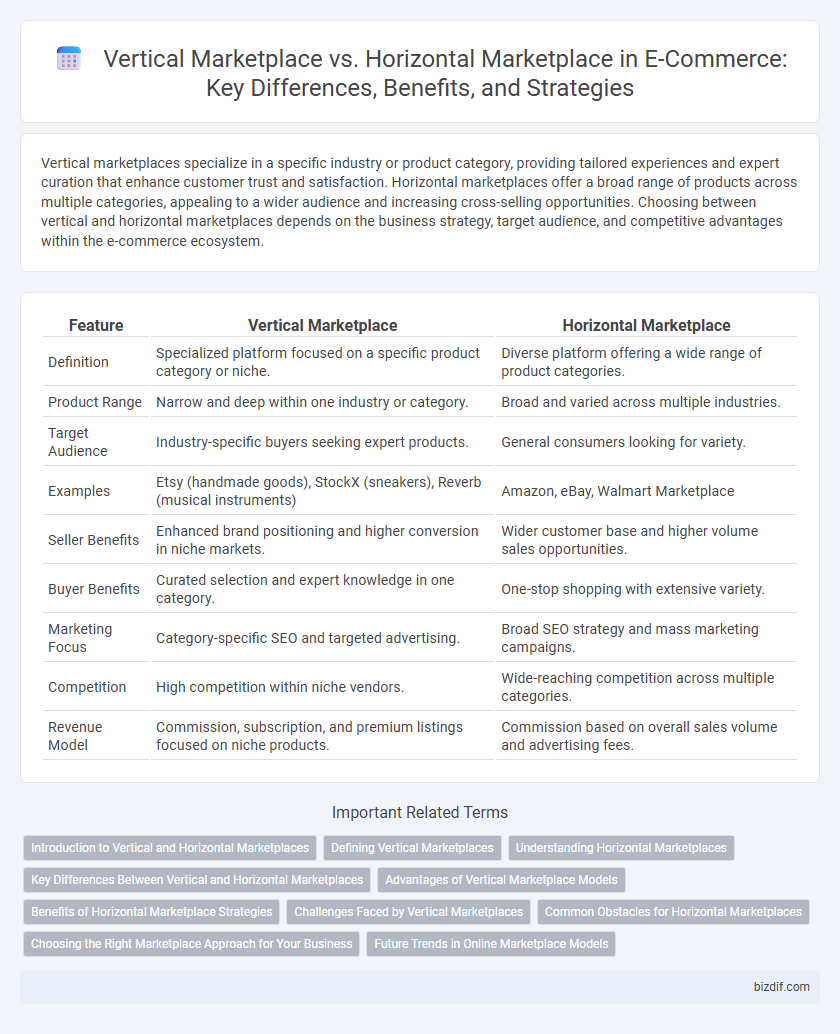Vertical marketplaces specialize in a specific industry or product category, providing tailored experiences and expert curation that enhance customer trust and satisfaction. Horizontal marketplaces offer a broad range of products across multiple categories, appealing to a wider audience and increasing cross-selling opportunities. Choosing between vertical and horizontal marketplaces depends on the business strategy, target audience, and competitive advantages within the e-commerce ecosystem.
Table of Comparison
| Feature | Vertical Marketplace | Horizontal Marketplace |
|---|---|---|
| Definition | Specialized platform focused on a specific product category or niche. | Diverse platform offering a wide range of product categories. |
| Product Range | Narrow and deep within one industry or category. | Broad and varied across multiple industries. |
| Target Audience | Industry-specific buyers seeking expert products. | General consumers looking for variety. |
| Examples | Etsy (handmade goods), StockX (sneakers), Reverb (musical instruments) | Amazon, eBay, Walmart Marketplace |
| Seller Benefits | Enhanced brand positioning and higher conversion in niche markets. | Wider customer base and higher volume sales opportunities. |
| Buyer Benefits | Curated selection and expert knowledge in one category. | One-stop shopping with extensive variety. |
| Marketing Focus | Category-specific SEO and targeted advertising. | Broad SEO strategy and mass marketing campaigns. |
| Competition | High competition within niche vendors. | Wide-reaching competition across multiple categories. |
| Revenue Model | Commission, subscription, and premium listings focused on niche products. | Commission based on overall sales volume and advertising fees. |
Introduction to Vertical and Horizontal Marketplaces
Vertical marketplaces specialize in a specific industry or product category, offering targeted inventory and tailored customer experiences for niche markets such as fashion, electronics, or health products. Horizontal marketplaces provide a broad range of product categories, catering to a diverse customer base by aggregating multiple industries like general retail, electronics, and household goods. Understanding the distinction between vertical and horizontal marketplaces helps e-commerce businesses optimize platform strategy, marketing efforts, and customer segmentation for maximum impact.
Defining Vertical Marketplaces
Vertical marketplaces specialize in a specific industry or niche, offering a curated selection of products tailored to particular customer needs, such as fashion, electronics, or home goods. They provide in-depth expertise, targeted marketing, and specialized services that enhance user experience and streamline the buying process. By focusing on a single vertical, these marketplaces can foster stronger relationships with suppliers and customers, driving higher conversion rates and customer loyalty.
Understanding Horizontal Marketplaces
Horizontal marketplaces aggregate a wide variety of product categories across multiple industries, offering consumers extensive choices in one platform, such as Amazon or eBay. These marketplaces leverage vast inventories and broad customer segments to maximize sales volume and enhance market reach. Understanding horizontal marketplaces is crucial for e-commerce businesses aiming to scale through diversified product offerings and tapping into large, cross-industry consumer bases.
Key Differences Between Vertical and Horizontal Marketplaces
Vertical marketplaces specialize in a specific industry or product category, offering curated selections and tailored services that enhance buyer-seller trust and streamline the purchasing process. Horizontal marketplaces feature a wide variety of products across multiple categories, prioritizing diversity and convenience for consumers seeking one-stop shopping experiences. Key differences include the target audience focus, product range depth, and personalized customer engagement in vertical marketplaces versus the broad reach and volume-driven approach in horizontal marketplaces.
Advantages of Vertical Marketplace Models
Vertical marketplace models offer specialized product selections that cater to targeted customer segments, enhancing user experience and increasing conversion rates. By focusing on a specific niche, these marketplaces enable deeper expertise, personalized marketing, and tailored customer service, leading to higher customer loyalty. Operational efficiencies are improved through streamlined inventory management and vendor relationships within the vertical category.
Benefits of Horizontal Marketplace Strategies
Horizontal marketplaces aggregate a diverse range of products across multiple categories, enhancing customer convenience and increasing cross-selling opportunities. This broad product selection attracts a larger customer base, driving higher traffic and sales volumes while enabling economies of scale in marketing and logistics. Leveraging horizontal marketplace strategies improves brand visibility and customer retention by meeting varied consumer demands in one unified platform.
Challenges Faced by Vertical Marketplaces
Vertical marketplaces face challenges such as limited customer base due to niche specialization, which restricts scalability and revenue growth. Managing supply chain complexities and ensuring consistent product quality within a specific industry further complicate operations. Additionally, vertical marketplaces often struggle with higher customer acquisition costs compared to broader horizontal platforms.
Common Obstacles for Horizontal Marketplaces
Horizontal marketplaces often face challenges related to managing diverse product categories, which complicates inventory management and quality control. They struggle with customer retention due to inconsistent user experiences across varied segments and lower brand loyalty compared to specialized vertical marketplaces. Handling diverse vendor requirements and maintaining robust search and recommendation algorithms are critical obstacles in scaling horizontal marketplaces effectively.
Choosing the Right Marketplace Approach for Your Business
Selecting the ideal marketplace approach depends on your business goals and target audience, with vertical marketplaces specializing in niche products and offering tailored customer experiences that drive higher conversion rates, while horizontal marketplaces provide a broad range of products attracting diverse customer segments and facilitating cross-selling opportunities. Vertical marketplaces excel in industries like fashion or electronics, leveraging deep product knowledge and curated selections to build brand loyalty, whereas horizontal marketplaces such as Amazon capture mass market demand by offering extensive product variety and competitive pricing. Analyzing customer behavior, product specificity, and competitive landscape will guide e-commerce businesses in adopting either vertical or horizontal marketplace strategies to maximize growth and profitability.
Future Trends in Online Marketplace Models
Vertical marketplaces prioritize specialized niches, offering tailored products and expert curation, driving deeper customer engagement and higher conversion rates. Horizontal marketplaces expand product diversity across multiple categories, leveraging vast user bases and broad market reach to maximize sales volume. Future trends indicate growing integration of AI-driven personalization and augmented reality in both models, enhancing the shopping experience and optimizing inventory management through predictive analytics.
Vertical Marketplace vs Horizontal Marketplace Infographic

 bizdif.com
bizdif.com